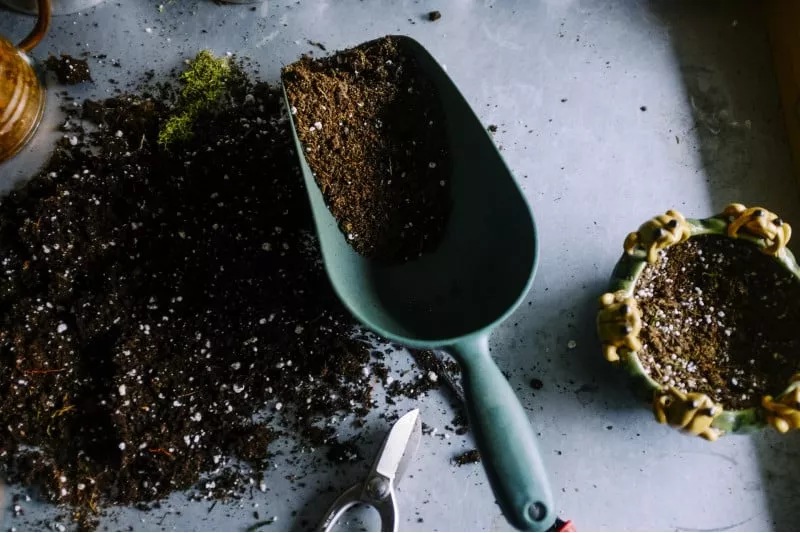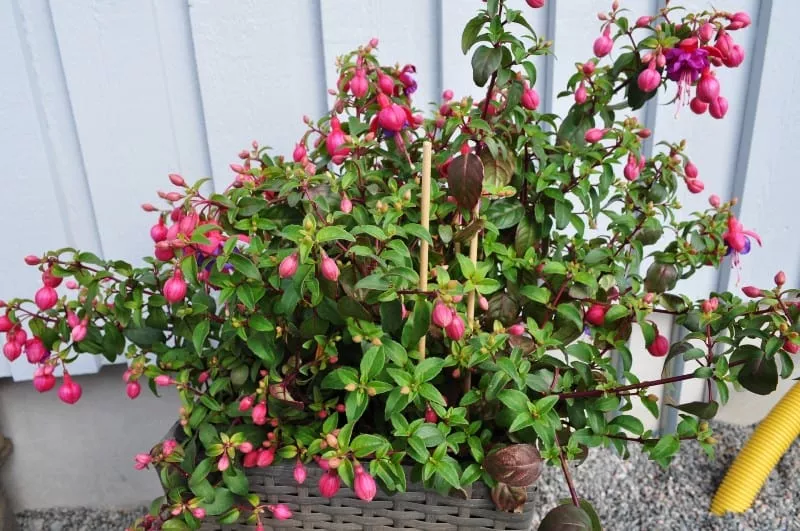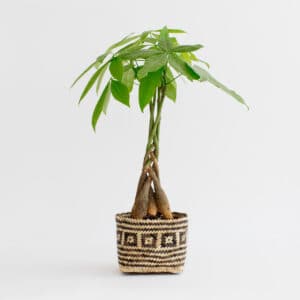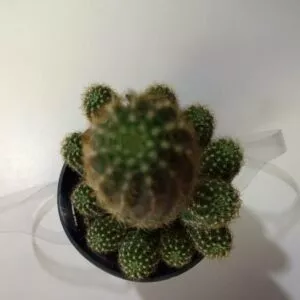No products in the cart.
Table of Contents
Did you know that the berries of most Fuchsia cultivars are edible? Yes, all parts of the plant are edible. However, berries are the most popular and widely consumed.
Depending on the cultivar, they have a variety of flavors ranging from acidic to sweet. And jams are the most common way to eat berries. Some of the berries are pretty small and seldom produced on the shrub.
What Is the Fuchsia Plant?
Fuchsia plants can be shrubs, trailing, miniature trees, or bedding plants. Plus, many collectors love to see them in hanging baskets! Fuchsias are well-known for their colorful, bell-shaped, bi-colored flowers that resemble dance skirts.
The standard Fuchsias flowers bloom all summer and come in a wide range of colors, including white, candy pink, magenta, purple, and red. Golden or variegated foliage and purple or red-tinged leaves can be found in some Fuchsia genera. Hummingbirds also pollinate these shrubs native to Central and South America.
Did the plant already catch your attention, and want to cultivate them? Well, I tell you now that having a new plant is never the wrong choice! Read below as we will tell you more about this beauty!
Fuchsia Plant Care

Now that you know what these Hardy plants are like, we will give you tips on properly caring for such a beauty! Enjoy reading!!
Potting Mix

Fuchsias are picky about the soil they grow in. It must not be excessively wet, dry, or heated. Fuchsia plants prefer moist soil (but not soggy), acidic, and have a high organic matter ratio.
Remember that the soil has to drain well! Modifying the pot filled with soil plus peat moss or compost is good before planting in-ground plants. Potted plants can thrive in any peat-based potting mix with adequate drainage.
Pro tip: Planting Fuchsia plants in soil with a pH of 6 to 7 is also essential for good fuchsia plant maintenance. They may, however, grow in various soil types as long as it drains well and rapidly.
Fuchsia Plants Lighting Requirement
Fuchsias thrive best with lots of bright light but are extremely heat-sensitive. A window with bright, indirect sunlight is ideal for growing these hardy plants indoors. Full sun is fine in foggy Coastal California or Pacific Northwest areas, where summers are cool.

Because fuchsia plants dislike hot soil, keep containers out of the sun for long periods. Plants exposed to too much direct sunlight may quickly lose their blossoms and wilt. So if you’re planning to grow them outdoors, place them in a partial shade.
Fuschia Plants Watering Needs
Fuchsias prefer damp, but not soggy, roots. Watering a potted Fuchsia daily is likely, but the simplest way to tell if it needs watering is to insert your finger into the soil and see if it’s damp.
The roots of a potted Fuchsia plant may rot if the soil is too moist. Because if this happens, the roots may rot, destroying your lovely Fuchsia plant.
Pro tip: Full-blooming container plants may need to be watered twice daily in extremely hot and dry weather. If the soil is still damp, do not water a wilted plant in the middle of the day.
Ideal Temperature & Humidity

The recommended growing temperature for several varieties is 55 to 80 degrees Fahrenheit (12.7 to 26.6 degrees Celsius).
At higher temperatures, some Fuchsias stop producing flowers. Grow Fuchsias where the summers are naturally cool. Fuchsia plant care in hotter climates must be precise to keep these bloomers happy.
When exposed to cold winter temperatures, most Fuchsia plants will die. Some types, on the other hand, can endure more freezing temperatures.
So when you notice that your plant isn’t cold-resistant, bring them indoors and store them till the following year.
Necessary Fertilizer of Fuchsia plant
Look after your plants in March and April because this impacts how well they develop and bloom in their season.
Begin a regular fertilizing program in the spring, beginning with a bit of application once a week. A reasonable rule of thumb is to feed Fuchsias once a week with a half-strength balanced, water-soluble fertilizer.
A container plant needs regular feeding because there is little soil to keep nutrients, and frequent watering leaches them out faster. Withhold fertilizer in the fall to harden plants before they become dormant for the winter in cold winter climates.
Propagation
Ready to multiply your Fuchsia plants without buying? Yes! You can propagate them! The best way to grow other Fuchsia plants is to take stem cuttings in the early spring.
Here’s how you will do it:
Make a 2- to 4-inch cut immediately above the third pair of leaves to remove a 2- to 4-inch segment of stem tip.
Remove the bottom leaves and soak the cutting in the rooting hormone at the end.
Plant the cutting in a seed-starter mix, sand, perlite, and peat moss in a tray or pot.
Place the pot warmly and cover it with a loose clear plastic cover.
After three to four weeks, the roots should have developed enough to remove the lid.
You can repot the young plants in a larger container and bring them outside once new leaf growth is seen on the cutting.
Fuchsia Plant Growth Zone
These Fuchsia plants are hardy in USDA hardiness zones 10 to 11. Your Fuchsia may behave like a perennial, but in colder zones, you may need to replant in spring or move your plants indoors for the winter. If you reside in zones 6 or 7, you’ve undoubtedly chosen a “hardy” kind of Fuchsia for your garden.
Potting and Pruning
If you want it to look its best, you’ll need a big pot for your potted Fuchsia. Consider containers more significant than 10 inches in diameter: anything smaller than a 10-inch pot is insufficient for this outdoor plant.
Plus, most collectors love seeing them in hanging baskets. If these enormous pots aren’t an option for you, don’t worry, lesser varieties of Fuchsia plants can be grown in 8-inch pots.
Because the Fuchsia plant blooms best when slightly pot-bound and has shallow roots, don’t rush it into a larger pot. You can repot the plant in the same container to refresh the soil when it reaches the desired size.
When pruning upright Fuchsias, remove deadwood and most of the previous year’s growth. Only a few robust vertical canes should be left. A hanging basket’s clipped branches should ideally resemble the spokes of a wagon wheel.
This is also an excellent time to prune the roots of container plants. Plus, pruning and clipping off stems produce bushier plants.
Fuchsia Varieties and Similar Plants
More than 100 species of woody shrubs and small trees belong to the Fuchsia genus. The hybrid of selected species is frequently offered as garden plants, bred for their vivid flowers and adaptable growing habits. Ready to know more about these beauties? We’ve provided some of them below:
‘Swingtime’ (Fuschia ‘Swingtime’)
In moderately warm climates, the exotic flowers of the hybrid ‘Swingtime’ fuchsias will bloom in your hanging baskets.
The red-white color scheme is completed with bright red stamens that contrast with the deeply ruffled white petals.
‘Swingtime’ produces fuchsia flowers up and down the length of the plant, producing a highly flowered effect, even though the heaviest flower production happens towards the ends of the stems.
‘Lady in Black’ (Fuchsia ‘Lady in Black’)
In fuchsia, ‘Lady in Black’ fills a new niche. During the extended blooming season, the half-hardy plants can rise up to 6 feet and produce hundreds of flowers at a time. Because ‘Lady in Black’ climbs by twining tendrils, provide a trellis or fence with fine wires or mesh to cling to.
‘Dollar Princess’ (Fuchsia ‘Dollar Princess’)
‘Dollar Princess’ is a versatile color that works well in warm and cold colors. Despite its exotic appearance, this hardy Fuchsia can withstand temperatures as low as 5 degrees in the winter. New delicate growth will sprout in the spring from the shrub’s woody branches, which are part of the shrub’s permanent structure.
Fuchsia Plant Diseases & Pests
These Fuchsia plants may be susceptible to pests and diseases if improperly handled. And it is best to know about them and the possible treatment! Don’t worry because we will also tell you about it.
Pests
The whitefly can be a significant concern in hot climates. Careful practice of removing infested leaves, vacuuming adults, or hosing down with water sprays can keep whitefly populations in check in the early phases of population development.
Insecticidal soaps or oils, such as neem oil, may help to lower populations but not completely eliminate them.
Remember that the underside of the leaves should not be overlooked! All sprays should be tested beforehand; fragile leaves and blossoms are quickly burned.
Also, watch for the Fuchsia gall mites, a tiny mite that feeds on the plant’s juices and then injects poison into the plant, causing gnarled and crippled growth akin to peach leaf curl.
Stems, leaves, and flowers expand and develop a hairy, galled appearance. They can also be treated with horticultural oil.
Diseases
Rust is a cool-weather illness that is most prevalent in the fall. To prevent this illness, allow plenty of space for air to circulate around your plants. Plants should not be overcrowded!
Pick off and discard any damaged leaves, and avoid overhead watering, which encourages spore development.
Give your plants more exposure to the sun. When watering, prune to enhance ventilation and don’t dampen the leaves.
Use a weak bleach solution to disinfect your secateurs. If necessary, use a certified fungicide.
Frequently Asked Questions
To maintain your Fuchsia plant to produce flowers throughout the summer, pinch it frequently. Pinching your Fuchsia is as simple as pinching or trimming the end of each branch one-quarter to one-half. If your Fuchsia has stopped blooming, it should start flowering within six weeks of this pinching.
Fuchsias are delicate perennial flowers. This means that if you live in a hot area, you can grow these plants outside, and they will come back year after year. On the other hand, Fuchsias are grown as annuals in many colder locations and are considered as an outdoor plant after all danger of frost has gone.
Fuchsias will naturally drop their dead flowers, so deadheading Fuchsia plants isn’t necessary if you just want to keep things tidy. However, when the flowers fall to the ground, they leave behind seed pods, which need the energy to produce and inhibit the formation of new flowers.
Most gardeners discard the potted Fuchsia plants when winter approaches. Some growing tips are to keep them indoors over winter. But you need humidity to grow Fuchsias for it to be successful. Or you can cut them back a few inches to place them in a dry climate and dark location. Only water to keep the soil moist to prevent it from getting bone dry. When spring arrives, you can take them outside to recover.
Depending on the variety, the Fuchsia plants can come back yearly as a perennial, while others you plant annually. But Fuchsia flowers growing as shrubs can live for several years.
These plants have a growth rate of one to two feet per year. However, remember that you’ll be pinching back the stems to create more blossoms, so your overall plant will unlikely grow that much in a year.
Whether you want to buy, sell or simply reach out to other plant enthusiasts, Plantly is the right place to be!
-
$6.00Sold By: Smoot's Farm
In stock
Succulent Succulent Haworthia Herbacea 2″ Pot Live Plant
Only 5 available and it’s in 1 people’s basketRated 4.89 out of 5 based on 27 customer ratings00Sold By: Smoot's Farm -
$44.00Sold By: NEEPA HUT
In stock
6″ Braided Money Tree Plant + Planter Basket
Only 10 available and it’s in 3 people’s basketRated 4.99 out of 5 based on 221 customer ratings06Sold By: NEEPA HUT -
$11.99Sold By: Succulent Oasis
In stock
Cactus Plant Medium Chamaelobivia “Rose Quartz”
Rated 4.84 out of 5 based on 352 customer ratings02Sold By: Succulent Oasis -
$12.99Sold By: BubbleBlooms
In stock
Pilea peperomioides / Chinese money plant / Chinese missionary plant
Only 993 available and it’s in 4 people’s basketRated 4.81 out of 5 based on 279 customer ratings04Sold By: BubbleBlooms






